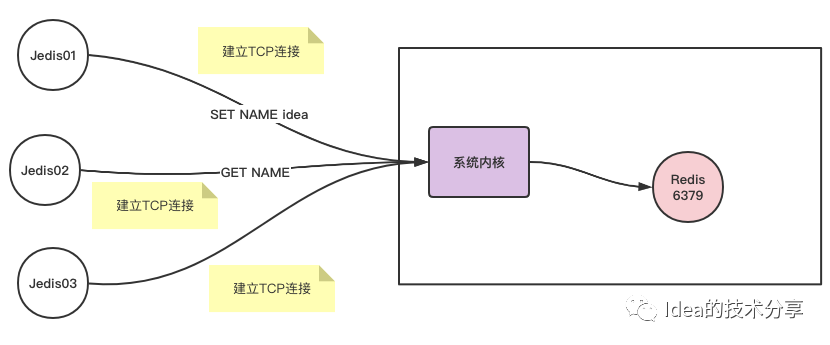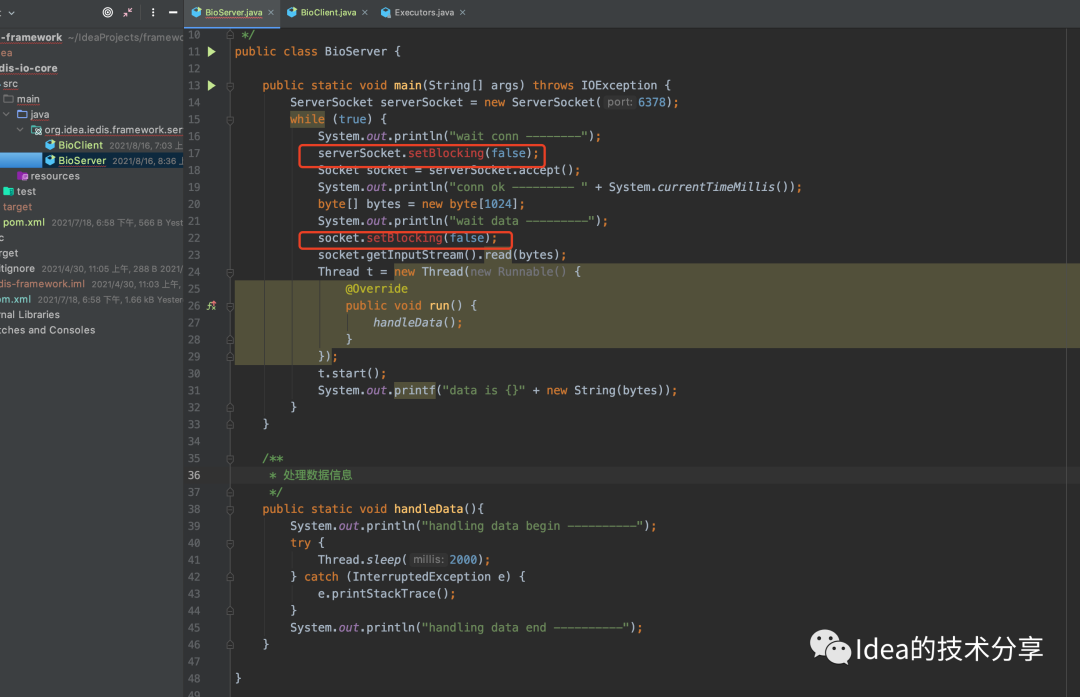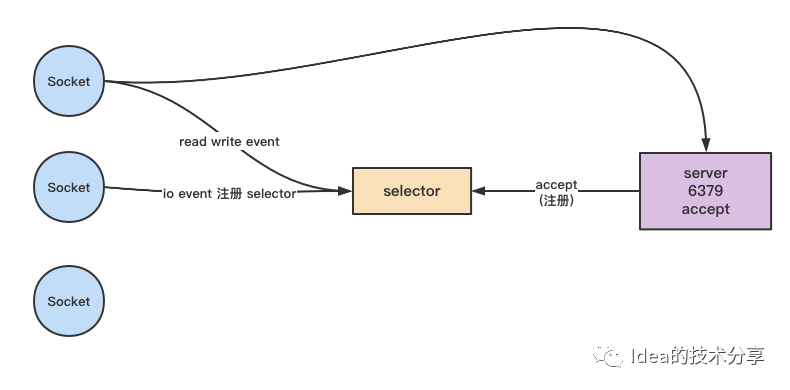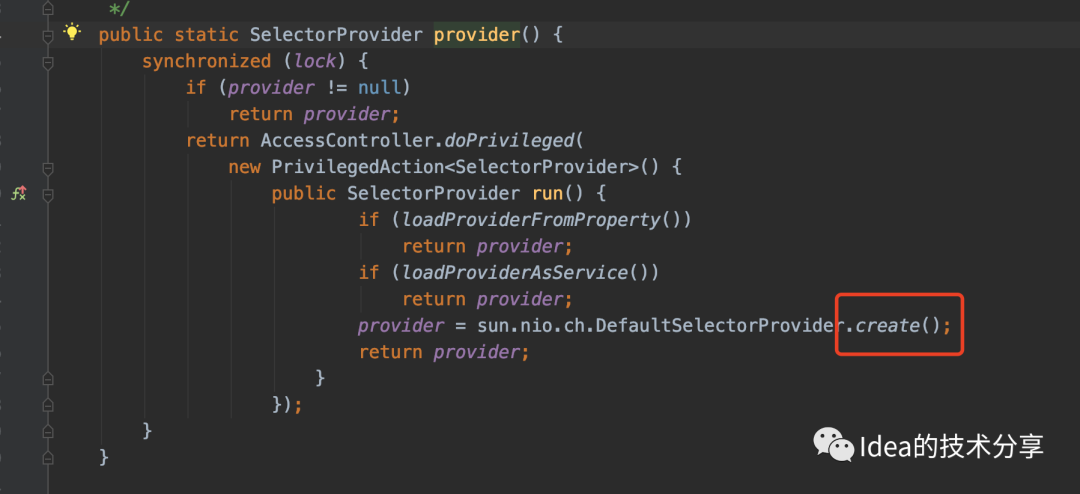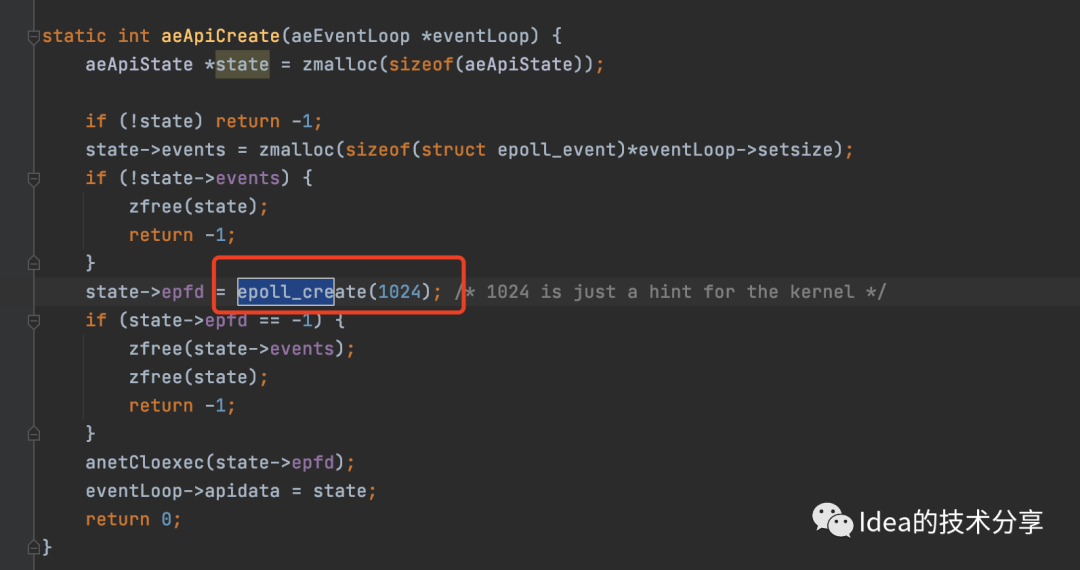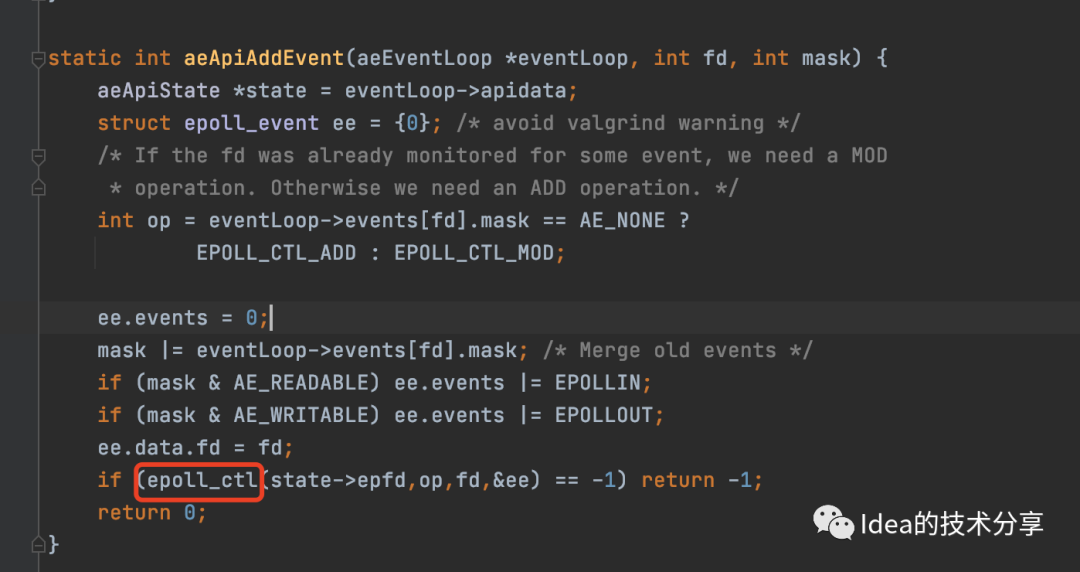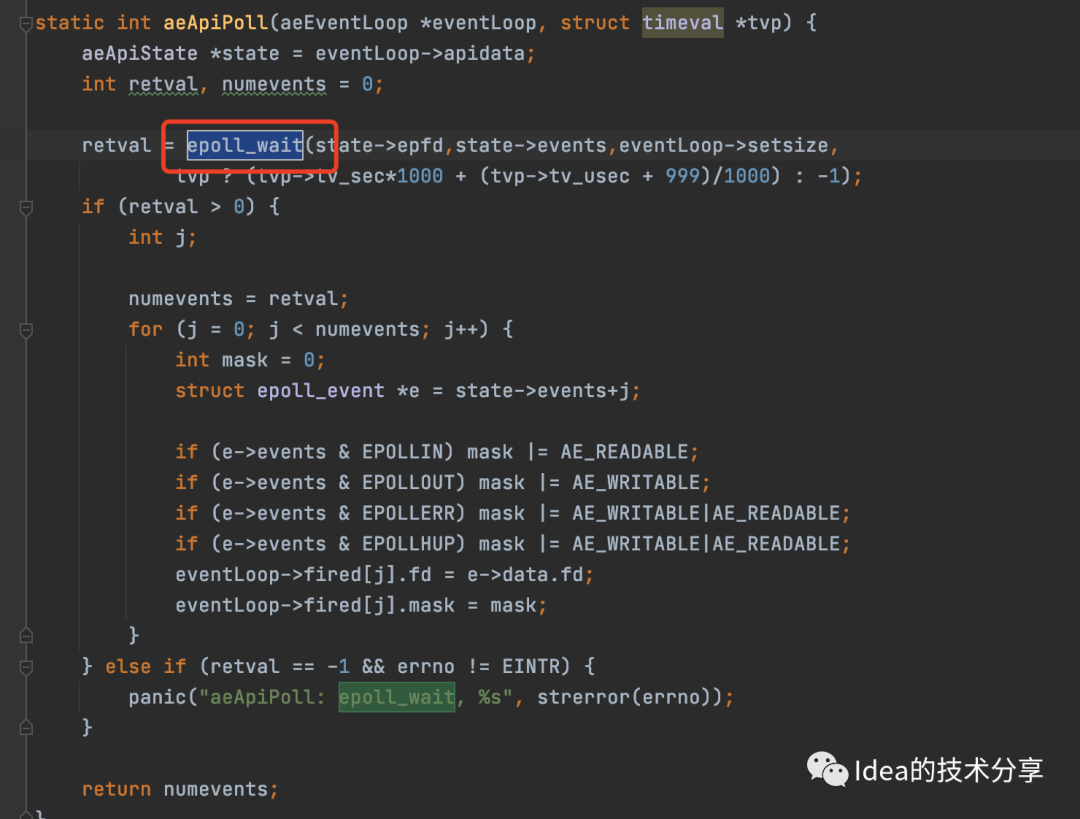大话Redis系列--深入探讨多路复用(上)
今天让我们一起来探讨一下多路复用在redis中的具体实现原理。
R**edis客户端和服务端的连接访问介绍**
之前的文章中我们有稍微提到过,Redis的客户端和服务端之间是通过resp协议进行链接通信的。这种通信的本质其实是借助了socket套接字进行网络连接。如下图所示:
当客户端的jedis和redis服务器进行连接的时候,首先需要在对应操作系统的内核中建立连接,接着才会将对应的链接分配到指定的redis服务端程序当中。假设redis采用了默认的6379端口,那么对应的链接请求就会发送到对应的进程上。
如何理解多路复用
当请求处理完毕之后,这一整条的链接链路不会立马断开,而为维持长链接的状态,方便后续继续传输数据使用。
为了方便大家对于多路复用能有个更好的认识,我们接下来通过一段Java程序来认识多路复用的实际应用案例。
Java模拟实现服务端链接
这是一段非常简单的BIO程序,大概思路便是接纳外界链接请求,然后打印数据到控制台。
package org.idea.iedis.framework.server.io.core;
import java.io.IOException;
import java.net.ServerSocket;
import java.net.Socket;
/**
* @Author linhao
* @Date created in 11:16 上午 2021/8/15
*/
public class BioServer {
public static void main(String[] args) throws IOException {
ServerSocket serverSocket = new ServerSocket(6378);
while (true) {
System.out.println("wait conn --------");
Socket socket = serverSocket.accept();
System.out.println("conn ok ---------");
byte[] bytes = new byte[1024];
System.out.println("wait data ---------");
socket.getInputStream().read(bytes);
System.out.printf("data is {}" + new String(bytes));
}
}
}
测试的方式我采用了nc命令进行模拟:
【idea @ Mac】>>>>>>nc localhost 6378
a当请求到达服务端的时候,也会在控制台有所打印输出:
上边代码的哪些点是堵塞的位置?
serverSocket.accept(); //堵塞部分
socket.getInputStream().read(bytes); //堵塞部分我们通过实操可以发现,在accept的位置会出现第一次堵塞的情况,当没有外界连接接入的时候,程序就会堵塞在该位置。
第二次堵塞的位置是在read函数调用的位置,当连接建立之后,服务端会一直等待客户端发送的数据请求,因此一直处于等待状况。
如果第一个连接建立之后迟迟不发送数据,后续又有第二个连接接入会出现什么问题?
为了模拟这个场景,我们来看下以下测试案例:
首先是服务端程序的部分改造,对于客户端的请求,我这里新增了一个handleData函数,用于模拟处理数据时候的堵塞情况(耗时大约为2秒左右)
package org.idea.iedis.framework.server.io.core;
import java.io.IOException;
import java.net.ServerSocket;
import java.net.Socket;
/**
* @Author linhao
* @Date created in 11:16 上午 2021/8/15
*/
public class BioServer {
public static void main(String[] args) throws IOException {
ServerSocket serverSocket = new ServerSocket(6378);
while (true) {
System.out.println("wait conn --------");
Socket socket = serverSocket.accept();
System.out.println("conn ok --------- " + System.currentTimeMillis());
byte[] bytes = new byte[1024];
System.out.println("wait data ---------");
socket.getInputStream().read(bytes);
handleData();
System.out.printf("data is {}" + new String(bytes));
}
}
/**
* 处理数据信息
*/
public static void handleData(){
System.out.println("handling data begin ----------");
try {
Thread.sleep(2000);
} catch (InterruptedException e) {
e.printStackTrace();
}
System.out.println("handling data end ----------");
}
}接着便是客户端部分的模拟,模拟五个客户端的连接服务端,并且发送数据:
package org.idea.iedis.framework.server.io.core;
import java.io.IOException;
import java.net.InetSocketAddress;
import java.net.Socket;
import java.util.concurrent.Executors;
import java.util.concurrent.LinkedBlockingQueue;
import java.util.concurrent.ThreadPoolExecutor;
import java.util.concurrent.TimeUnit;
/**
* @Author linhao
* @Date created in 11:17 上午 2021/8/15
*/
public class BioClient {
public static final ThreadPoolExecutor threadPoolExecutor = new ThreadPoolExecutor(2, 5,
0L, TimeUnit.MILLISECONDS,
new LinkedBlockingQueue<Runnable>());
public static void main(String[] args) {
for (int i = 0; i < 5; i++) {
Thread t = new Thread(new Runnable() {
@Override
public void run() {
Socket socket = new Socket();
try {
socket.connect(new InetSocketAddress("localhost", 6378));
socket.getOutputStream().write("this is test".getBytes());
System.out.println("send data -----------" + System.currentTimeMillis());
socket.close();
} catch (IOException e) {
e.printStackTrace();
}
}
});
threadPoolExecutor.submit(t);
}
Thread.yield();
}
}
通过请求的日志记录可以发现,服务端对于数据的处理时间点如下:
也就是说当上一个连接在处理请求的时候,下一个连接发送的数据会处于一个就绪状态,单线程依次执行。
多线程异步等待模型改造
将服务端处理线程请求的模块开启单独的线程进行处理。
服务端程序进行改造:
package org.idea.iedis.framework.server.io.core;
import java.io.IOException;
import java.net.ServerSocket;
import java.net.Socket;
/**
* @Author linhao
* @Date created in 11:16 上午 2021/8/15
*/
public class BioServer {
public static void main(String[] args) throws IOException {
ServerSocket serverSocket = new ServerSocket(6378);
while (true) {
System.out.println("wait conn --------");
Socket socket = serverSocket.accept();
System.out.println("conn ok --------- " + System.currentTimeMillis());
byte[] bytes = new byte[1024];
System.out.println("wait data ---------");
socket.getInputStream().read(bytes);
Thread t = new Thread(new Runnable() {
@Override
public void run() {
handleData();
}
});
t.start();
System.out.printf("data is {}" + new String(bytes));
}
}
/**
* 处理数据信息
*/
public static void handleData(){
System.out.println("handling data begin ----------");
try {
Thread.sleep(2000);
} catch (InterruptedException e) {
e.printStackTrace();
}
System.out.println("handling data end ----------");
}
}
此时控制台打印出来的结果如下所示:
看起来似乎是请求处理的效率变高了,但是实际上这种方案对于性能的开销是比较大的。
- 假设我们同时有1000个请求发送过来,那么服务端就得启动1000个线程处理。
- 假设建立了1000个连接,但是其中只有10条连接发送了数据,那么这个开销从利用率来说更加不划算。
其实在tomcat7之前,其服务端的程序一直都是采用bio的模式来进行处理请求数据,每次发送请求之后都需要额外创建一个线程处理数据,因此其并发处理能力并不友好。
改善思路
- 当没有建立服务端连接的时候,accept函数调用的时候不要出现阻塞,而是直接跳过。
- 在没有数据抵达服务端的时候,read函数调用采用非阻塞的方式执行。
有了这两个思路点之后,我们再来深入思考:
假设我们是jdk的开发者,需要对现有的代码做怎样的调整?
这里分享一下我自己的思路:
首先ServerSocket是一个已经存在于JDK内部的对象,而且不建议随意对已有的api进行调整,否则会对业界使用者造成一个不兼容的情况。
因此不妨可以通过一些setter方法去修改阻塞的设置项:
来看看实际JDK开发者是如何改良这部分设计的:
首先是使用nio搭建一个简单的服务端代码案例:
package org.idea.iedis.framework.server.io.core.nio;
import java.io.IOException;
import java.net.InetSocketAddress;
import java.net.SocketAddress;
import java.nio.ByteBuffer;
import java.nio.channels.ServerSocketChannel;
import java.nio.channels.SocketChannel;
import java.util.ArrayList;
import java.util.List;
/**
* @Author linhao
* @Date created in 8:41 上午 2021/8/16
*/
public class NioServer {
static ByteBuffer byteBuffer = ByteBuffer.allocate(1024);
static List<SocketChannel> channelList = new ArrayList<>();
public static void main(String[] args) throws IOException {
ServerSocketChannel serverSocketChannel = ServerSocketChannel.open();
SocketAddress socketAddress = new InetSocketAddress("localhost", 6666);
serverSocketChannel.bind(socketAddress);
serverSocketChannel.configureBlocking(false);
//有点类似于poll模型
while (true) {
for (SocketChannel socketChannel : channelList) {
int read = socketChannel.read(byteBuffer);
if (read > 0) {
System.out.println("read ... " + read);
byteBuffer.flip();
byte[] bs = new byte[read];
byteBuffer.get(bs);
String content = new String(bs);
System.out.println(content);
byteBuffer.flip();
}
}
SocketChannel accept = serverSocketChannel.accept();
if (accept != null) {
System.out.println("conn success -----");
accept.configureBlocking(false);
channelList.add(accept);
System.out.println(channelList.size() + "---- list --- size");
}
}
}
}
接着是基于这套服务端代码去编写相关的客户端程序脚本:
package org.idea.iedis.framework.server.io.core.nio;
import java.io.IOException;
import java.net.InetSocketAddress;
import java.nio.ByteBuffer;
import java.nio.channels.SocketChannel;
/**
* @Author linhao
* @Date created in 8:40 上午 2021/8/16
*/
public class NioClient {
public static void main(String[] args) throws IOException, InterruptedException {
SocketChannel socketChannel = SocketChannel.open();
socketChannel.connect(new InetSocketAddress("localhost", 6666));
socketChannel.configureBlocking(false);
socketChannel.write(ByteBuffer.wrap("this is a test".getBytes()));
System.out.println("-----");
}
}上边的这段代码总体的执行思路其实可以抽像化为以下模式:(假设有三个链接请求)
select (3 sockets){
for(Socket socket: sockets) {
int read = socket.getInputStream();
if(read >0){
// 对应处理代码
} else {
// 对应处理代码
}
}
}但是这样的代码我们在进行实际落地实现的时候不可能采用Java程序去实现,通常都是在os底层来进行封装,然后供高级语言去调用。
思考:
假设构建了100w条链接,那么对于这一批的链接采用暴力的list遍历方式去询问是否有新数据的写入就会显得效率异常低下。
改善点:
假设当我们建立好了链接请求之后,每个链接都会订阅某个事件,假设是有数据写入的时候,主动去发布这个事件,这样就能避免轮训操作了。
NIO内部如何解决多路复用机制
从这个角度思考出发,我们一起来看下nio内部是如何实现多路复用机制的,
当有新的请求过来的时候,server会提前将accept事件委托给selector处理。
selector会根据连接的事件类型(例如read,write,accept)去通知到具体的socketserver。
来看看案例代码:
服务端新增一个selector代码
package org.idea.iedis.framework.server.io.core.nio.selector;
import java.io.IOException;
import java.net.InetSocketAddress;
import java.net.SocketAddress;
import java.nio.ByteBuffer;
import java.nio.channels.SelectionKey;
import java.nio.channels.Selector;
import java.nio.channels.ServerSocketChannel;
import java.nio.channels.SocketChannel;
import java.util.ArrayList;
import java.util.Iterator;
import java.util.Set;
/**
* @Author linhao
* @Date created in 8:27 上午 2021/8/17
*/
public class NioSelectorServer {
static ArrayList<SocketChannel> socketChannels = new ArrayList<>();
static ByteBuffer byteBuffer = ByteBuffer.allocate(1024);
public static void main(String[] args) throws IOException {
ServerSocketChannel serverSocket = ServerSocketChannel.open();
SocketAddress socketAddress = new InetSocketAddress("localhost", 6555);
serverSocket.configureBlocking(false);
serverSocket.bind(socketAddress);
Selector selector = Selector.open();
serverSocket.register(selector, SelectionKey.OP_ACCEPT);
System.out.println("start select!");
while (true) {
selector.select();
Set<SelectionKey> selectionKeys = selector.selectedKeys();
Iterator<SelectionKey> iterator = selectionKeys.iterator();
while (iterator.hasNext()) {
SelectionKey selectionKey = iterator.next();
if (selectionKey.isAcceptable()) {
SocketChannel socketChannel = serverSocket.accept();
socketChannel.configureBlocking(false);
socketChannel.register(selector, SelectionKey.OP_READ);
System.out.println("client is connected!");
} else if (selectionKey.isReadable()) {
SocketChannel socketChannel = (SocketChannel) selectionKey.channel();
ByteBuffer byteBuffer = ByteBuffer.allocate(1024);
int len = socketChannel.read(byteBuffer);
if (len > 0) {
System.out.println("receive data!" + new String(byteBuffer.array(),0,len));
} else if (len == -1) {
System.out.println("client is close");
socketChannel.close();
}
}
iterator.remove();
}
}
}
}
客户端向服务端发送数据的案例代码:
package org.idea.iedis.framework.server.io.core.nio.selector;
import java.io.IOException;
import java.net.InetSocketAddress;
import java.nio.ByteBuffer;
import java.nio.channels.SocketChannel;
/**
* @Author linhao
* @Date created in 8:53 上午 2021/8/17
*/
public class NioSelectorClient {
public static void main(String[] args) throws IOException, InterruptedException {
SocketChannel socketChannel = SocketChannel.open();
socketChannel.connect(new InetSocketAddress("localhost",6555));
socketChannel.configureBlocking(false);
while (true) {
System.out.println("client send data");
socketChannel.write(ByteBuffer.wrap(("this is success " + Thread.currentThread().getName()).getBytes()));
Thread.sleep(2500);
}
}
}
从上边服务端的程序案例可以看出,首先获取到链接之后,会将一个接收事件(accept)给注册到一个叫做selector的组件上。接下来后续这个链接如果有发送请求到数据过来就会被识别是read事件,此时selector再会去通知具体到服务线程处理。大概到思路如下图所示:
思考:
selector在进行select的时候,会发生什么情况?
如果外界没有额外请求进入的话,那么select函数会进入一个堵塞等待的状态。看起来效果有些类似于bio的accept函数。
selector调用open函数,它会发生了什么变化?
我们对selector的open函数源代码进行深入挖掘,可以发现具体如下所示:
在其源代码的底部调用了JDK内部的sun.nio.ch.DefaultSelectorProvider.create()函数。这个函数的代码底层实际上会调用到jdk内部的一些函数,再由jdk内部去调用一些native方法,最终会调用到os中的接口,假设该程序所运作的os环境是linux操作系统,那么最底层就会调用到epool相关的三个函数。
epoll_create,epoll_ctl,epoll_wait。
Redis底层源代码中是如何实现多路复用的
这里我打开的是redis6.0的源代码进行阅读:
文件名称:ae_epoll.c
ps:由于自己对于C源代码并不是特别熟悉,所以这里只能简单说下
下边的这张截图中体现了使用epoll_create函数取创建一个链接。
这段代码则是使用了epollo_ctl函数来处理一些事件的注册处理。
下边的epoll_wait看起来则像是监听某些兴趣事件。
由于文章篇幅有限,后边会接着出一篇文章继续深入研究下多路复用的内容。
